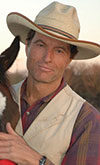Many stockmen have trouble getting their cattle into the corral. One reason is: The corral is someplace the cattle don’t freely want to go because of past experiences. Another reason is: Some handlers aren’t using good techniques and instead choose to blame their miserable old cows or look for any possible excuse.
One excuse is the common belief that cattle are afraid of the corral. But consider Photo 1. I did a big circle hunting for strays without success, so I rode back to the corral – and guess what I found? My strays were standing in the corral. So they’re really afraid of the corral, aren’t they?
Another common belief is: We will have trouble because cattle don’t want to go through the gate. But are cattle actually afraid of the gate? What happens if you leave a gate open, whether in a corral or pasture? They find it and go through it, right?
From the low-stress perspective, cattle handling expert Bud Williams makes the point that cattle aren’t afraid of the corral or gate; it’s how we bring them in and what we do to them before we get there that matters.
If we have trouble, it’s because of what we are doing. We are in the wrong position, doing the wrong thing, applying too much pressure – or we probably don’t have good, straight movement before we get to the corral.
In addition to having good, straight movement heading for the gate, it’s also helpful to have someone near the gate to ride reverse-parallel (toward the cattle but just off to one side within their pressure zone). This draws the cattle’s attention to the gate, and as they see you coming they will speed up to get past you, which puts them in the corral.
Corral work begins before we get to the corral
Williams stresses that corral work begins long before we get cattle to the corral: “It’s really important to understand that if you want them to work really well through your system, you need to bring ’em in properly.
How you bring cattle into the corral influences how the animals work at every stage through your system, whether sorting, weighing, putting ’em through the squeeze, loading in trucks, whatever.” And if we bring them in poorly, they won’t be cooperative because they’ll be upset, and their minds will be set on going back.
Overcrowding
Cattle don’t like being crowded any more than we do. Overcrowding pens – which most stockmen do – increases stress and anxiety, making cattle less easy to work with, increasing shrink and making being in a herd a bad experience.
As a general rule, don’t fill any pen more than half-full. This will allow cattle to have plenty of space to move around and remain calm.
Being efficient
Corrals are what Lynn Locatelli, a veterinarian and low-stress handling specialist, describes as “bovine obstacle courses,” and it’s our job to help cattle negotiate the course while minimizing stress.
Cattle standing in a corral will lose on average about one-half of 1 percent of their bodyweight every 30 minutes. Hence, it behooves us to get our corral work done quickly and efficiently with minimal stress, but conventional handlers erroneously think working livestock in a low-stress manner is slow and takes too much time.
The opposite is actually true: The way to work animals fast is to work them effectively – that is, work them properly, and we will get our work done in less time.
So to help you in your corral work efforts, let’s take a look at six basic techniques for efficiently doing some aspects of corral work:
1. Emptying a pen from the back
Conventionally, everyone wants to go in and get behind the animals and drive them out, so let’s start with that approach. If we use proper technique, we can easily empty a pen from the back. To do so, zigzag back and forth in straight lines at a forward angle behind the animals in a “T” to the gate, as depicted in Figure 1.
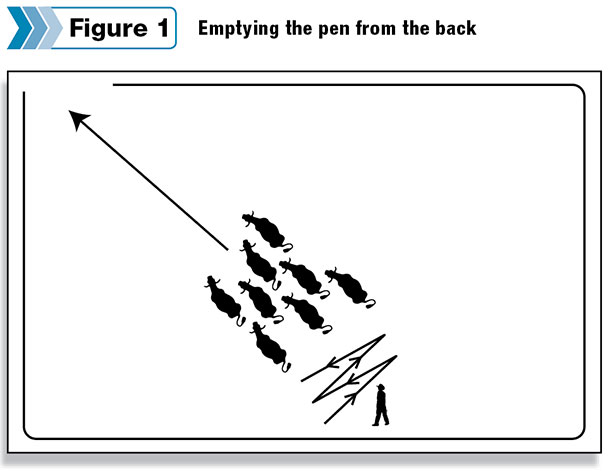
The zigzag generates movement by applying effective forward pressure into the animals’ sides, and the T establishes direction (animals tend to move straight away from the zigzag). It doesn’t matter if there are one, two or three people doing this; the technique is the same.
2. Emptying a pen from the front
There are advantages to emptying a pen from the front:
- When we go in and pressure from the front, cattle will see where we want them to go, and they will want to go by us because that’s what they like to do, so they’re getting to do what they want and they’re doing what we want.
- We can control the speed of movement from the front by moving forward and back (i.e., “reverse-parallel” and “forward-parallel”), which we can’t do from the back.
- We’re in a position to take only the number we want or to count them all out.
To empty a pen from the front, walk directly toward cattle. This draws their attention to you and the gate behind you. The lead cattle will split around you and head for the gate. As soon as the cattle start flowing out, you can stop and the pen will empty (Figure 2). This technique works best in a small pen.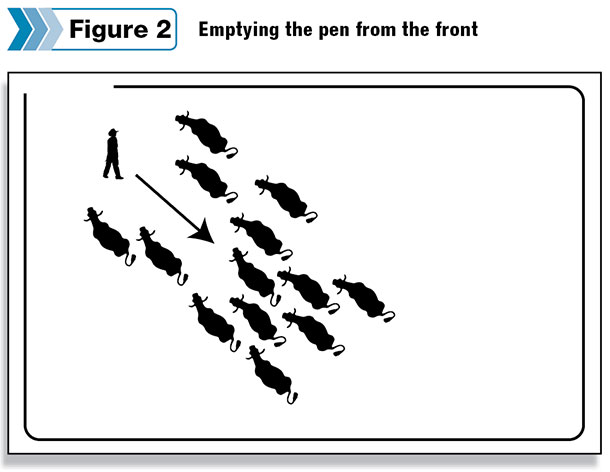
3. Emptying a pen using the inside arc
Another effective technique for emptying a pen is positioning yourself on the “inside arc” and pressuring in and out into the animals’ sides at a 45-degree angle to the back corner (Figure 3).
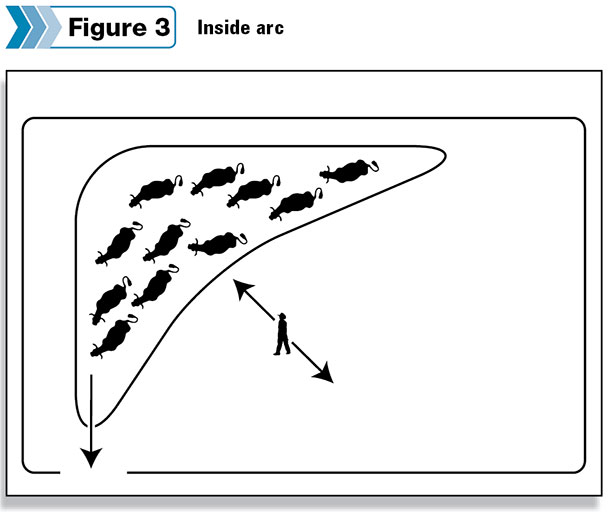
You pressure in to generate movement, move back out to guide them through the gate and repeat as necessary.
4. Getting cattle out of a corner
If cattle are in a corner but close to the gate, pressure into the corner at a 45-degree angle and back out (Figure 4).
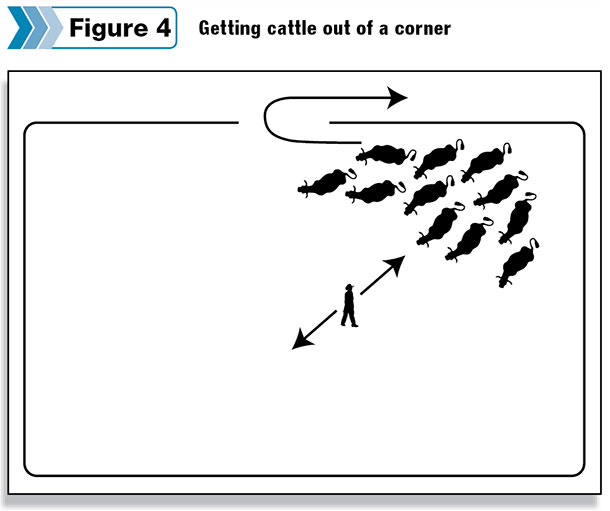
You have to back out for two reasons: so you can pressure in again if necessary and so you can guide them (i.e., it pressures the outside eye so they turn).
5. Alleyways
Conventionally, we use alleyways not only for livestock movement but also for storage. From the low-stress point of view, that’s very hard on animals.
Cattle don’t like to be crowded, so when they are their anxiety and stress levels go way up. They will unnecessarily shed pounds, and they’ll become less cooperative.
Also, whenever we store animals in an alleyway for some processing event, like weighing, each time we go in to get another draft, we mash them up against the back. This makes the whole corral experience bad, makes cattle harder to work the next time and makes the experience of being together in a herd bad.
If you’re going to use an alleyway to store cattle, you shouldn’t overcrowd it. Another thing I strongly recommend is putting someone behind the cattle to keep them from crowding back against the rear gate (Photo 2).
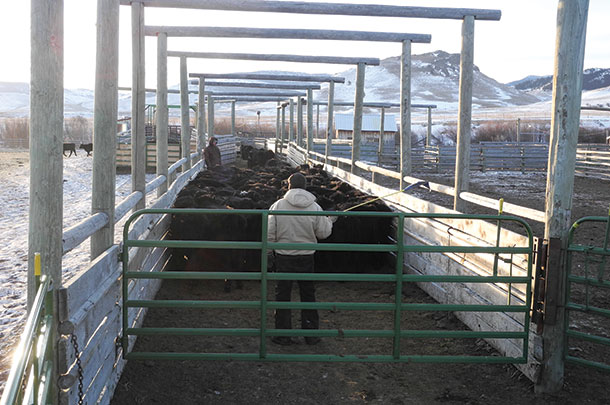
This person can also keep the animals’ heads forward, setting them up nicely for the person in front to peel off drafts for the scale, crowd pen, load-out or whatever.
Low-stress handlers prefer to store cattle in pens and only use alleyways for transport.
6. Driving animals up an alleyway
Conventionally, stock handlers fall in right behind animals and push, often with the aid of noise, a prod and even a dog. This is unnecessary, stressful and often results in some animals wanting to turn back.
The best way to drive cattle up an alleyway is with the zigzag (Figure 5).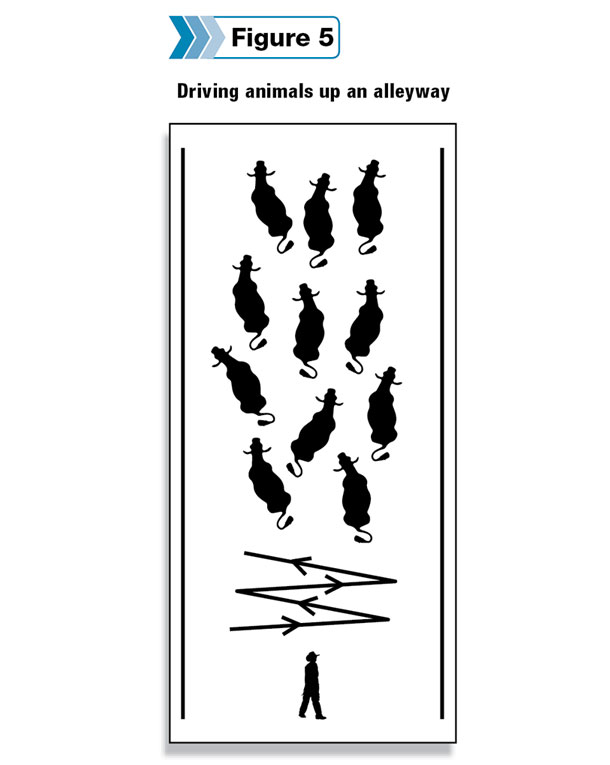
Dry runs
Before doing a performance of some kind, we do a rehearsal to prepare, right? Well, why don’t we do that with our livestock? We should.
A rehearsal, or “dry run,” through your corral system – like with weaner calves, replacement heifers, stockers, newly purchased cattle – is so easy to do and takes so little time but will pay huge dividends in the future in the form of saved time, effort and stress.
For instance, bring your weaner calves into the corral, run them across the open scale, then through the crowd pen, down the chute and through the open squeeze. This way they learn the route, that there’s a way out, and there is nothing to fear.
Conclusion
With these techniques in place, you will be able to do the same amount of work in less time, with fewer people, with less stress (on both animals and the crew) and will reduce shrink – all of which saves you money. ![]()
Whit Hibbard is a fourth-generation Montana rancher and editor of the Stockmanship Journal.
PHOTO 1: If the right handling techniques are used, cattle will willingly go into the corral.
PHOTO 2: Put someone behind the cattle to keep them from crowding back against the rear gate. Photos courtesy of Whit Hibbard.

-
Whit Hibbard
- Rancher
- Helena, Montana
- Email Whit Hibbard
